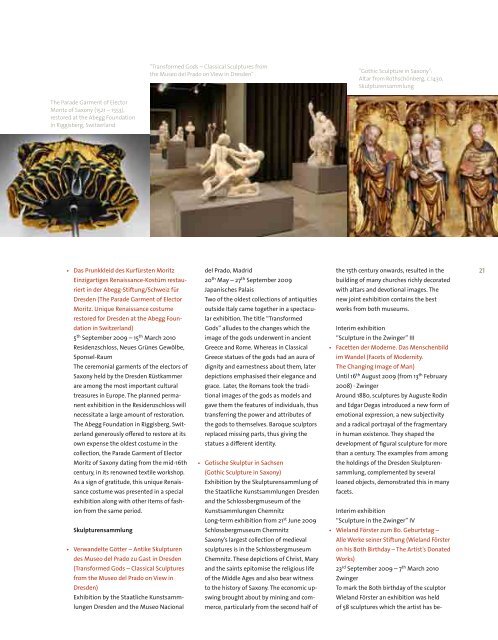2009 - Staatliche Kunstsammlungen Dresden
2009 - Staatliche Kunstsammlungen Dresden
2009 - Staatliche Kunstsammlungen Dresden
You also want an ePaper? Increase the reach of your titles
YUMPU automatically turns print PDFs into web optimized ePapers that Google loves.
The Parade Garment of Elector<br />
Moritz of Saxony (1521 – 1553),<br />
restored at the Abegg Foundation<br />
in Riggisberg, Switzerland<br />
• Das Prunkkleid des Kurfürsten Moritz<br />
Einzigartiges Renaissance-Kostüm restauriert<br />
in der Abegg-Stiftung/Schweiz für<br />
<strong>Dresden</strong> (The Parade Garment of Elector<br />
Moritz. Unique Renaissance costume<br />
restored for <strong>Dresden</strong> at the Abegg Foun-<br />
dation in Switzerland)<br />
5th September <strong>2009</strong> – 15th March 2010<br />
Residenzschloss, Neues Grünes Gewölbe,<br />
Sponsel-Raum<br />
The ceremonial garments of the electors of<br />
Saxony held by the <strong>Dresden</strong> Rüstkammer<br />
are among the most important cultural<br />
treasures in Europe. The planned permanent<br />
exhibition in the Residenzschloss will<br />
necessitate a large amount of restoration.<br />
The Abegg Foundation in Riggisberg, Switzerland<br />
generously offered to restore at its<br />
own expense the oldest costume in the<br />
collection, the Parade Garment of Elector<br />
Moritz of Saxony dating from the mid-16th<br />
century, in its renowned textile workshop.<br />
As a sign of gratitude, this unique Renaissance<br />
costume was presented in a special<br />
exhibition along with other items of fashion<br />
from the same period.<br />
Skulpturensammlung<br />
• Verwandelte Götter – Antike Skulpturen<br />
des Museo del Prado zu Gast in <strong>Dresden</strong><br />
(Transformed Gods – Classical Sculptures<br />
from the Museo del Prado on View in<br />
<strong>Dresden</strong>)<br />
Exhibition by the <strong>Staatliche</strong> <strong>Kunstsammlungen</strong><br />
<strong>Dresden</strong> and the Museo Nacional<br />
”Transformed Gods – Classical Sculptures from<br />
the Museo del Prado on View in <strong>Dresden</strong>”<br />
del Prado, Madrid<br />
20th May – 27th September <strong>2009</strong><br />
Japanisches Palais<br />
Two of the oldest collections of antiquities<br />
outside Italy came together in a spectacular<br />
exhibition. The title “Transformed<br />
Gods” alludes to the changes which the<br />
image of the gods underwent in ancient<br />
Greece and Rome. Whereas in Classical<br />
Greece statues of the gods had an aura of<br />
dignity and earnestness about them, later<br />
depictions emphasised their elegance and<br />
grace. Later, the Romans took the traditional<br />
images of the gods as models and<br />
gave them the features of individuals, thus<br />
transferring the power and attributes of<br />
the gods to themselves. Baroque sculptors<br />
replaced missing parts, thus giving the<br />
statues a different identity.<br />
• Gotische Skulptur in Sachsen<br />
(Gothic Sculpture in Saxony)<br />
Exhibition by the Skulpturensammlung of<br />
the <strong>Staatliche</strong> <strong>Kunstsammlungen</strong> <strong>Dresden</strong><br />
and the Schlossbergmuseum of the<br />
<strong>Kunstsammlungen</strong> Chemnitz<br />
Long-term exhibition from 21st June <strong>2009</strong><br />
Schlossbergmuseum Chemnitz<br />
Saxony’s largest collection of medieval<br />
sculptures is in the Schlossbergmuseum<br />
Chemnitz. These depictions of Christ, Mary<br />
and the saints epitomise the religious life<br />
of the Middle Ages and also bear witness<br />
to the history of Saxony. The economic upswing<br />
brought about by mining and commerce,<br />
particularly from the second half of<br />
”Gothic Sculpture in Saxony”:<br />
Altar from Rothschönberg, c.1430,<br />
Skulpturensammlung<br />
the 15th century onwards, resulted in the<br />
building of many churches richly decorated<br />
with altars and devotional images. The<br />
new joint exhibition contains the best<br />
works from both museums.<br />
Interim exhibition<br />
“Sculpture in the Zwinger” III<br />
• Facetten der Moderne. Das Menschenbild<br />
im Wandel (Facets of Modernity.<br />
The Changing Image of Man)<br />
Until 16th August <strong>2009</strong> (from 13th February<br />
2008) · Zwinger<br />
Around 1880, sculptures by Auguste Rodin<br />
and Edgar Degas introduced a new form of<br />
emotional expression, a new subjectivity<br />
and a radical portrayal of the fragmentary<br />
in human existence. They shaped the<br />
development of figural sculpture for more<br />
than a century. The examples from among<br />
the holdings of the <strong>Dresden</strong> Skulpturensammlung,<br />
complemented by several<br />
loaned objects, demonstrated this in many<br />
facets.<br />
Interim exhibition<br />
“Sculpture in the Zwinger” IV<br />
• Wieland Förster zum 80. Geburtstag –<br />
Alle Werke seiner Stiftung (Wieland Förster<br />
on his 80th Birthday – The Artist’s Donated<br />
Works)<br />
23rd September <strong>2009</strong> – 7th March 2010<br />
Zwinger<br />
To mark the 80th birthday of the sculptor<br />
Wieland Förster an exhibition was held<br />
of 58 sculptures which the artist has be-<br />
21

















